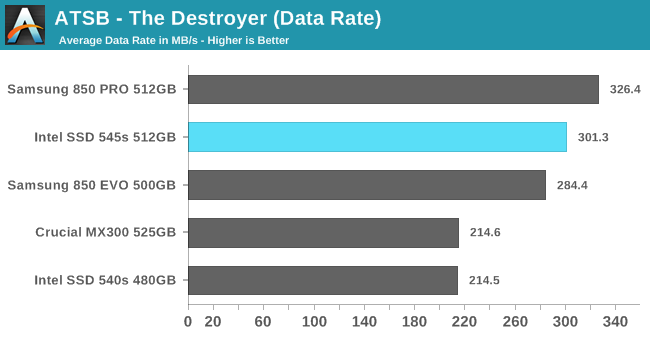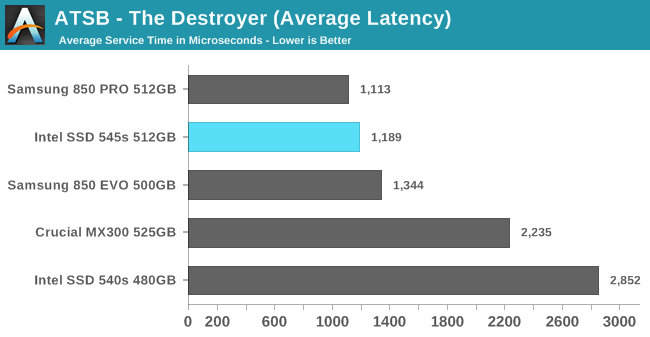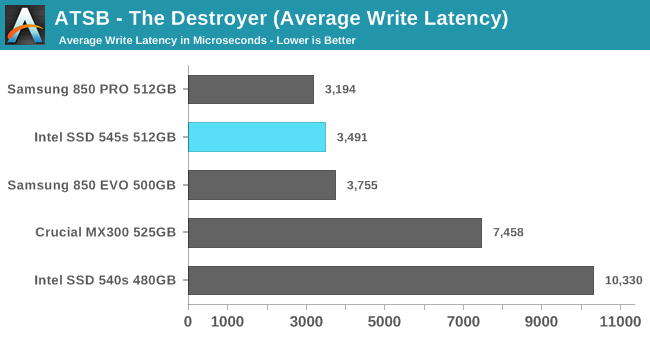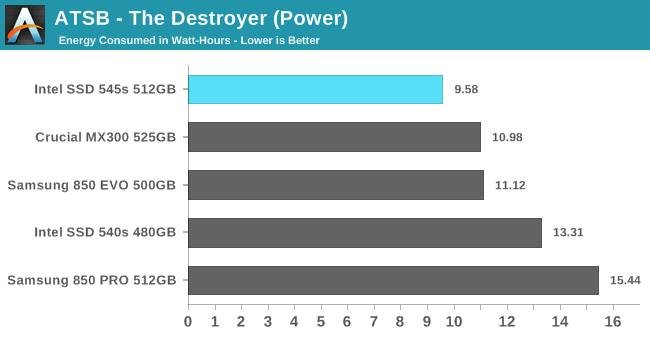The Intel SSD 545s (512GB) Review: 64-Layer 3D TLC NAND Hits Retail
by Billy Tallis on June 27, 2017 6:00 AM ESTAnandTech Storage Bench - The Destroyer
The Destroyer is an extremely long test replicating the access patterns of very IO-intensive desktop usage. A detailed breakdown can be found in this article. Like real-world usage, the drives do get the occasional break that allows for some background garbage collection and flushing caches, but those idle times are limited to 25ms so that it doesn't take all week to run the test. These AnandTech Storage Bench (ATSB) tests do not involve running the actual applications that generated the workloads, so the scores are relatively insensitive to changes in CPU performance and RAM from our new testbed, but the jump to a newer version of Windows and the newer storage drivers can have an impact.
We quantify performance on this test by reporting the drive's average data throughput, the average latency of the I/O operations, and the total energy used by the drive over the course of the test.

The Intel SSD 545s performs surprisingly well on The Destroyer, with an average data rate that surpasses the Samsung 850 EVO and potentially makes the 545s the new fastest SATA SSD with 3D NAND. The 3D MLC-based Samsung 850 PRO is still out of reach, but the 545s is a big improvement over the 540s and the Crucial MX300.

The Intel 545s also ranks between the Samsung 850 PRO and 850 EVO in terms of average latency, with slightly more than half the latency of the Crucial MX300 and an even wider margin over the Intel 540s.


Separating the latency according to reads and writes, we see that the 545s is much closer to the Samsung 850 PRO than the 850 EVO for reads. The write latencies of the Samsung drives and the 545s are all much lower than the Crucial MX300 or Intel 540s.

In addition to delivering great performance for a SATA TLC SSD, the Intel 545s brings a huge improvement in power efficiency. The 545s uses 12% less energy than the Crucial MX300 or Samsung 850 EVO over the course of the test. Only a few SSDs have ever completed The Destroyer on such a small energy budget, and only one other TLC SSD has been this efficient.










74 Comments
View All Comments
ddriver - Tuesday, June 27, 2017 - link
Actually yes. Way to go intel...anactoraaron - Tuesday, June 27, 2017 - link
What's wrong with the 600p? You can get the 512gb from newegg for $179, which make me question the 545s price point. If you aren't limited to sata, the 600p 512gb makes much more sense.ddriver - Tuesday, June 27, 2017 - link
"What's wrong with the 600p? "Nothing, aside from the fact it is THE lousiest NVME SSD in the known universe...
Drumsticks - Tuesday, June 27, 2017 - link
Good thing it generally sells at SATA prices then...junky77 - Wednesday, June 28, 2017 - link
It's really not even as fast as SATA SSDs in many tests (I'm talking midrange SSDs, nothing fancy)kaidenshi - Wednesday, June 28, 2017 - link
I've seen a ton of hate for the 600p here, and I can only conclude that I got extremely lucky with mine and ended up with a fluke. Mine has been hands down the fastest SSD I've ever had, and even paired with a bargain-basement Pentium G4500 CPU, it makes everything on my PC feel instant.Perhaps it is the slowest NVMe SSD one can buy, but it is much, much faster than any SATA SSD I've had in this machine. It definitely blows the doors off the 850 Evo, despite claims I've seen here that it's slower. The results on this site mirror what I've seen in my own testing. Basically, the Samsung beats the Intel on random reads only, but loses spectacularly on all other metrics.
http://ssd.userbenchmark.com/Compare/Samsung-850-E...
Samus - Thursday, June 29, 2017 - link
It isn't a speed demon, but it isn't slow either. It's just what you'd expect for the price.And it's sequential transfer rates are substantially faster than anything SATA, so that is the icing on the cake for an SSD that sells for SATA prices.
And being Intel, I expect it will be ultimately more reliable than a similar priced product form ADATA, etc.
alpha754293 - Thursday, June 29, 2017 - link
What's wrong with the Intel 750 series PCIe NVMe SSDs?futrtrubl - Tuesday, June 27, 2017 - link
I'm going to assume the sustained sequential write speed of 40MB/s is a typo.futrtrubl - Tuesday, June 27, 2017 - link
Oh wow, I see it is not.